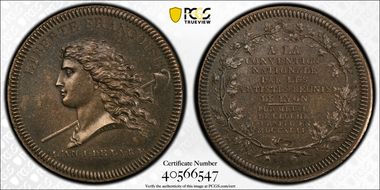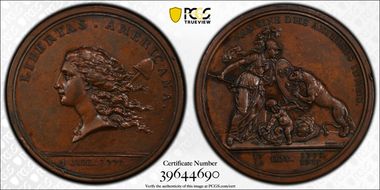Comet Coins 的钱币相册
Engraved by Augustin Dupre, this coin was minted to commemorate the ceremony that took place on the anniversary of the storming of the Bastille in 1792. The ceremony took place at the Campo Di Marte where, in a large amphitheater crowds as large as 400,000 gathered, with the likes of General Lafayette, Louis XVI, & the Bishop of Autun, all there to proclaim their solemn oath of fidelity to the new party established on July 14th in 1790.
After the Revolutionary War Great Britain was in financial ruin, which led to their faltered effort to continue to produce enough coinage for circulation. With this being the case private minting companies took the responsibility of producing coins into their own hands - so brought forth the creation of the commonly known "Condor Token". The Sole Example Certified. Obv: A Druid's head facing left within an oak wreath. Rev: A shield of arms beneath a coronet. A full half ounce of 18th c copper, made from dies first engraved by Jean-Pierre Droz and struck by Matthew Boulton.. The Cornish Metal Company, was set up in 1785 as the marketing component of the county's united miners. The company soon failed, and by 1787 was taken over by Thomas Williams who controlled sales until 1792.
The Libertas Americana medal is one of the most famous and cherished of all the medals relating to American history. According to the historical record, the brainchild for the medal and its designs was none other than Benjamin Franklin. In a March 1782 letter to Robert Livingston, U.S. Secretary for Foreign Affairs, Franklin wrote, "This puts me in mind of a medal I have had a mind to strike ... representing the United States by the figure of an infant Hercules in his cradle, strangling the two serpents; and France by that of Minerva, sitting by as his nurse, with her spear and helmet, and her robe specked by a few 'fleurs-de-lis. In addition, The obverse of the medal shows a head of Liberty with flowing hair, facing right, a freedman's cap atop a pole in the background. This model served as the inspiration for some of the U.S. Pattern coinage of 1792 and for the first U.S. Half Cents in 1793.























